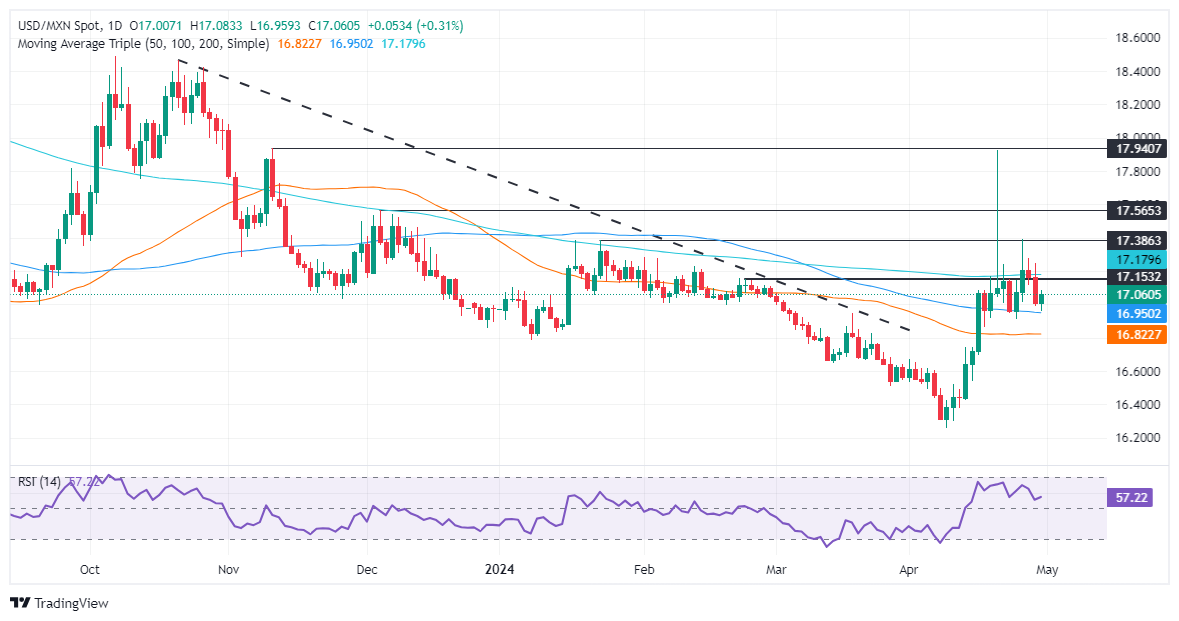Mexican Peso slumps as Q1 GDP disappoints, US Dollar strengthens

- Mexican Peso falls over 0.41% after Mexico’s Q1 GDP growth underperforms expectations.
- Stronger-than-expected US Employment Cost Index bolsters US Dollar, diminishing prospect for imminent Fed rate cut.
- Despite quarterly GDP growth exceeding expectations in Mexico, annual figures fail to meet forecasts, contributing to Peso’s decline.
The Mexican Peso tumbles more than 0.41% against the US Dollar on Tuesday, following the release of Mexico’s Gross Domestic Product (GDP) figures missing estimates for the first quarter on a yearly basis.
That alongside with a reacceleration of inflation, according to data revealed in the United States (US), weighed on the Mexican currency. The Greenback has recovered some ground though. At the time of writing, the USD/MXN trades at 17.08 after hitting a low of 16.95.
Mexico’s National Statistics Agency (INEGI) revealed that GDP for Q1 2024 grew 1.6% YoY, a slower pace than the 2.4% in the last quarter of 2023 and beneath estimates of 2.1%. However, on a quarterly basis, the country grew 0.2% higher than the previous reading of 0.1% and exceeded the consensus of 0%.
Across the border, the US economic docket was busy, as the Employment Cost Index (ECI) a measure used by the Federal Reserve to assess inflation on wages was higher than expected, decreasing the odds of a rate cut by Fed Chairman Jerome Powell and Co.
Recent data witnessed Consumer Confidence deteriorating in the US, according to April’s data by the Conference Board.
This week, the US economic docket will be busy, though the most significant events will be the releases of the ISM Manufacturing PMI and the Fed’s monetary policy decision on May 1, followed by the Nonfarm Payroll figures on Friday and the ISM Services PMI.
Daily digest market movers: Mexican Peso tumbles on soft GDP, strong US inflation data
- Data revealed in April showed that Mexico’s inflation was mixed as headline inflation rose, mostly attributed to a jump in Oil prices. Contrarily, underlying prices dipped, justifying the Bank of Mexico’s (Banxico) decision to lower rates.
- Although most analysts estimate Banxico will hold rates unchanged at 11.00%, new data could open the door for heated discussions among Banxico’s Governing Council members on May 9.
- Last week, Banxico Governor Victoria Rodriguez Ceja said the central bank would be data-dependent. However, weak GDP data could pave way for a “live meeting” on May 9.
- Citibanamex Survey showed that most analysts expect Banxico to hold rates unchanged at the May meeting. The median foresees a rate cut in June, while they estimate the main reference rate to end the year at 10.00%, up from 9.63% previously.
- A broad gauge of US labor costs closely watched by the Federal Reserve accelerated in the first quarter by more than forecast, illustrating persistent wage pressure that is keeping inflation elevated.
- US Employment Cost Index (ECI), a measure of wages and benefits, rose by 1.2% QoQ after rising 0.9% at the end of 2023, exceeding forecasts of 1%, according to Bureau of Labor Statistics (BLS). That would keep the Fed on its holding pattern as fears of inflation reaccelerating loom.
- US Conference Board (CB) Consumer Confidence dropped in April from 103.1 to 97, its lowest level since mid-2022 as Americans’ view of the job market and the outlook for the economy deteriorated.
- Fed is expected to keep rates unchanged at May 1 meeting, though traders will be eyeing Fed Chair Jerome Powell’s press conference. A hawkish tilt could trigger a jump in favor of the Greenback; otherwise, the USD/MXN could resume its downtrend.
- Data from the Chicago Board of Trade (CBOT) suggests that traders expect the fed funds rate to finish 2024 at 5.080%, up from 5.035% on Monday.
MXN technical analysis: Mexican Peso trips lower as USD/MXN edges toward 200-day SMA
The Mexican Peso is making a U-turn, depreciating on Tuesday as the USD/MXN edges up. Even though the pair sits below the weekly high of 17.24, it is approaching quickly toward the 200-day Simple Moving Average (SMA) at 17.17. Once surpassed, the next stop would be the January 23 swing high of 17.38, followed by the year-to-date (YTD) high of 17.92, ahead of 18.00.
On the other hand, if USD/MXN buyers fail to conquer the 200-day SMA, further losses are seen beneath the 17.00 threshold. Once cleared, the next stop would be the 50-day SMA at 16.81 before challenging last year’s low of 16.62.
Banxico FAQs
The Bank of Mexico, also known as Banxico, is the country’s central bank. Its mission is to preserve the value of Mexico’s currency, the Mexican Peso (MXN), and to set the monetary policy. To this end, its main objective is to maintain low and stable inflation within target levels – at or close to its target of 3%, the midpoint in a tolerance band of between 2% and 4%.
The main tool of the Banxico to guide monetary policy is by setting interest rates. When inflation is above target, the bank will attempt to tame it by raising rates, making it more expensive for households and businesses to borrow money and thus cooling the economy. Higher interest rates are generally positive for the Mexican Peso (MXN) as they lead to higher yields, making the country a more attractive place for investors. On the contrary, lower interest rates tend to weaken MXN. The rate differential with the USD, or how the Banxico is expected to set interest rates compared with the US Federal Reserve (Fed), is a key factor.
Banxico meets eight times a year, and its monetary policy is greatly influenced by decisions of the US Federal Reserve (Fed). Therefore, the central bank’s decision-making committee usually gathers a week after the Fed. In doing so, Banxico reacts and sometimes anticipates monetary policy measures set by the Federal Reserve. For example, after the Covid-19 pandemic, before the Fed raised rates, Banxico did it first in an attempt to diminish the chances of a substantial depreciation of the Mexican Peso (MXN) and to prevent capital outflows that could destabilize the country.
Information on these pages contains forward-looking statements that involve risks and uncertainties. Markets and instruments profiled on this page are for informational purposes only and should not in any way come across as a recommendation to buy or sell in these assets. You should do your own thorough research before making any investment decisions. FXStreet does not in any way guarantee that this information is free from mistakes, errors, or material misstatements. It also does not guarantee that this information is of a timely nature. Investing in Open Markets involves a great deal of risk, including the loss of all or a portion of your investment, as well as emotional distress. All risks, losses and costs associated with investing, including total loss of principal, are your responsibility. The views and opinions expressed in this article are those of the authors and do not necessarily reflect the official policy or position of FXStreet nor its advertisers. The author will not be held responsible for information that is found at the end of links posted on this page.
If not otherwise explicitly mentioned in the body of the article, at the time of writing, the author has no position in any stock mentioned in this article and no business relationship with any company mentioned. The author has not received compensation for writing this article, other than from FXStreet.
FXStreet and the author do not provide personalized recommendations. The author makes no representations as to the accuracy, completeness, or suitability of this information. FXStreet and the author will not be liable for any errors, omissions or any losses, injuries or damages arising from this information and its display or use. Errors and omissions excepted.
The author and FXStreet are not registered investment advisors and nothing in this article is intended to be investment advice.



